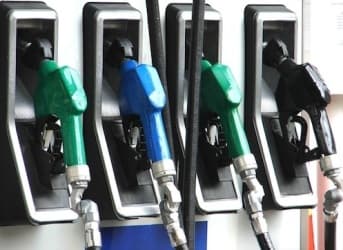Let’s end at the beginning: retail gasoline prices are going to continue to head lower, and this post simply presents the case as to why, through some simple visuals.

But before we do that, here are some reasons as to why that downside could be more limited than it otherwise should be:
–Stubbornly high input prices (h/t crude oil). The oil price accounts for approximately 65% of the cost of the retail price of gasoline
–Low profitability in refining gasoline (also known as the crack spread). Should crack spreads remain depressed, we could see producers cut back on gasoline production, therefore squeezing prices higher
–A rising, record volume of fuel exports (granted, the lion’s share of this is diesel, but hey)
Despite the reasons above, the case for lower gasoline prices seems fairly represented through the following images, which underscore potential downside – from supply to demand to stockpiles to seasonality……to a popped bubble known as RINs.
STOCKPILES: This first chart shows current gasoline stockpiles (all 220 million barrels of them). Current stock levels (yellow line) are above any level seen at this time of the year for the past half a decade.

DEMAND: This below chart highlights US gasoline demand over the past couple of decades. The choppiness in the line is seasonality (higher demand in the summer, lower in the winter). Nonetheless, the overall trend is the key takeaway: demand since 2007 has peaked, and the trend = gradually lower.

REFINING: Although there has been a fairly precipitous drop in refining in recent weeks as the seasonal maintenance season gets underway, this is by no means a rarity – as illustrated in the chart below. Refinery utilization has lagged the drop-off usually seen in September…but is playing catch-up now.
And even though we are down to 86% – a level not seen since April – we are still at the top of the five-year range, and just a smidgen shy of last year’s level. All the while, part of the recent drop-off in refining may well be attributable to Tropical Storm Karen. This all points to further healthy production of gasoline ahead.

RINs: The EPA requires refiners to blend a certain amount of biofuel into gasoline, based on the Renewable Fuel Standard (a total of 16.55 billion gallons this year). Which is all well and good, except that there is a limit as to how much ethanol can be safely blended into gasoline (considered to be, um, 10%).
Gasoline has now hit the ‘blend wall’ – the maximum limit – which leaves refiners two options: either keep blending, or buy RINs (Renewable Identification Numbers) – essentially paper offsets – to meet the obligations required.
RIN prices spiraled higher earlier in the year as it became clear that there was too much volume of biofuels in the RFS mandate to blend into a limited amount of gasoline (hark, demand falling – see above), which left the onus on refiners to either absorb the cost or pass it on down the supply chain.
As the chart below highlights, the spike in RINs correlates with the recent peak in gasoline prices in August. However, as rumors and murmurs emerge of the EPA cutting the mandate for corn ethanol next year, RINs are getting absolutely walloped, which should in turn help to put downward pressure on gasoline.

SEASONALITY: And finally…price. Not only should a crude oil price with limited upside potential keep a lid on gasoline, but the usual seasonal drop in demand and a move to a cheaper winter blend should also yield downward pressure on retail prices before year-end:

Given the evidence presented here, we will likely see a lower retail gasoline price in the coming months as we step into Christmas. But to temper that optimism a little, the descent is likely to be one of a more careful trek lower than a speedy downhill toboggan ride. Regardless, lower prices most likely await. As always, thanks for playing!
By Matt Smith


















